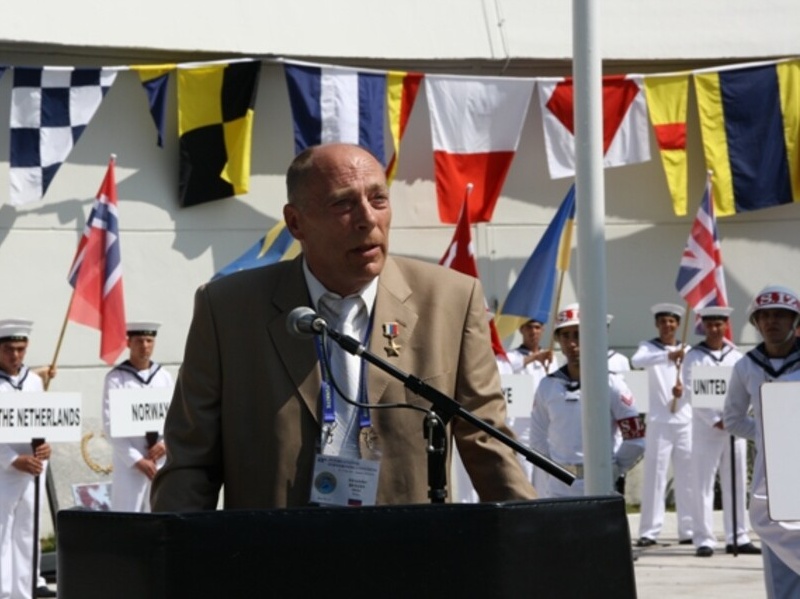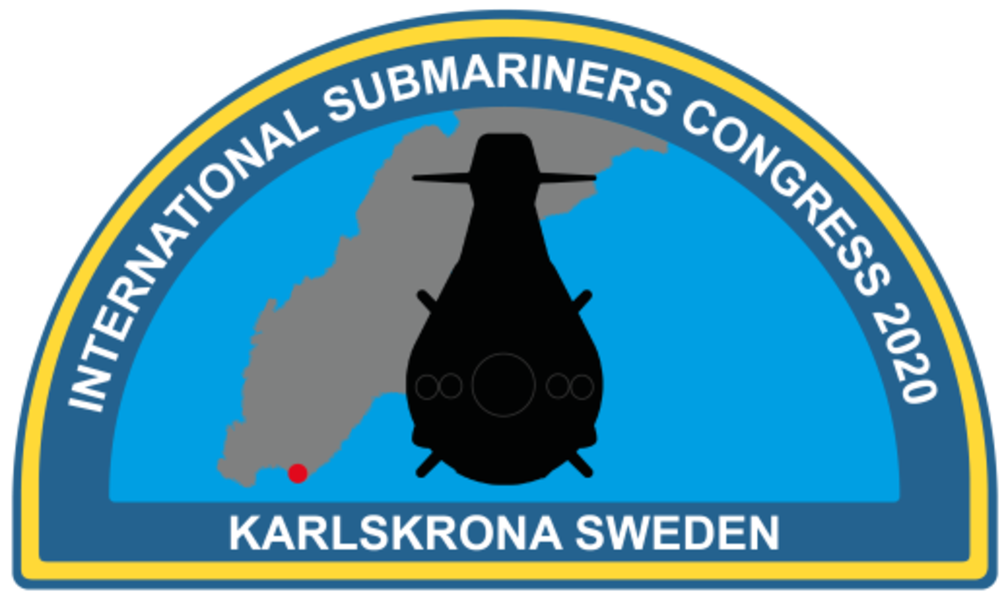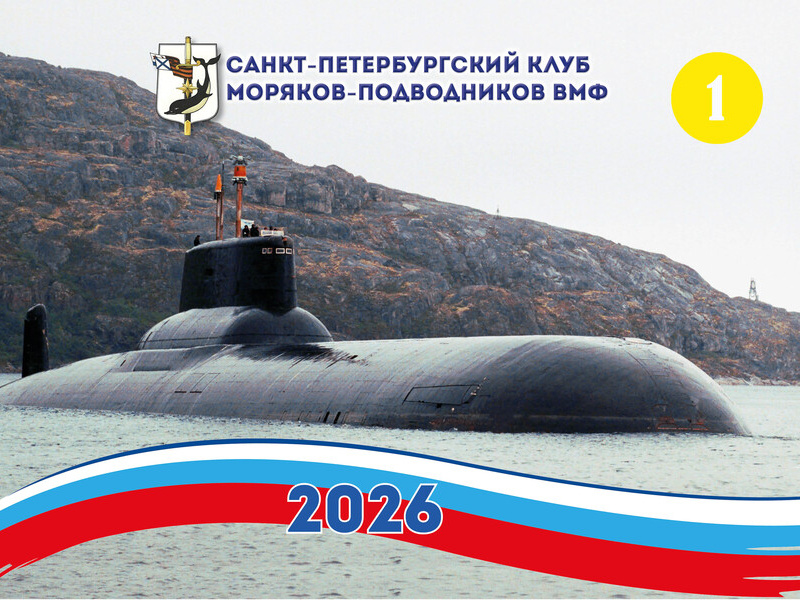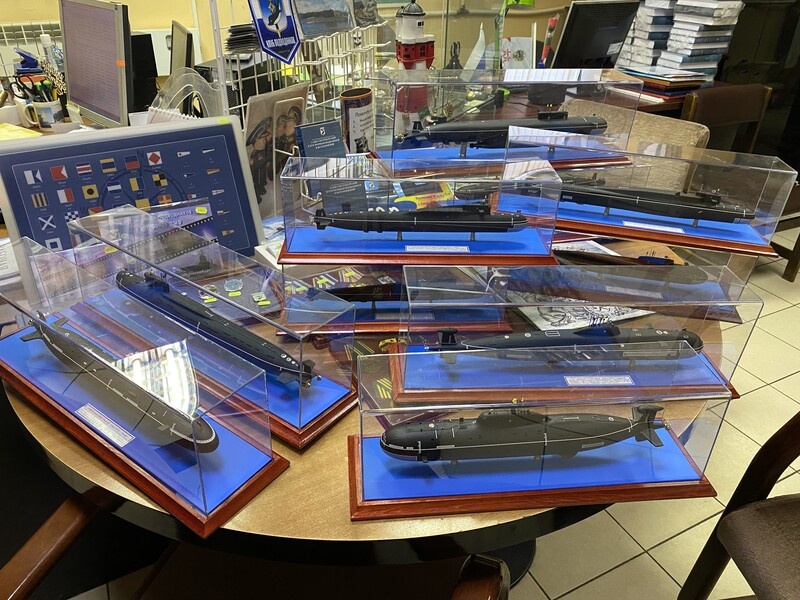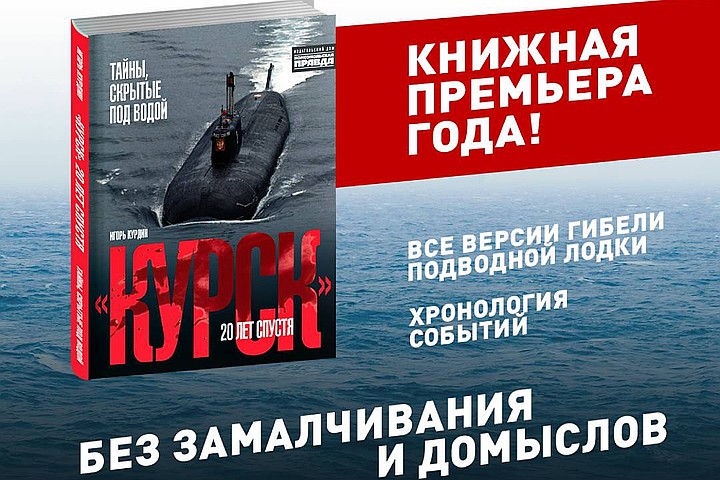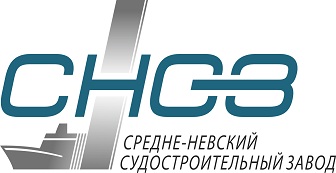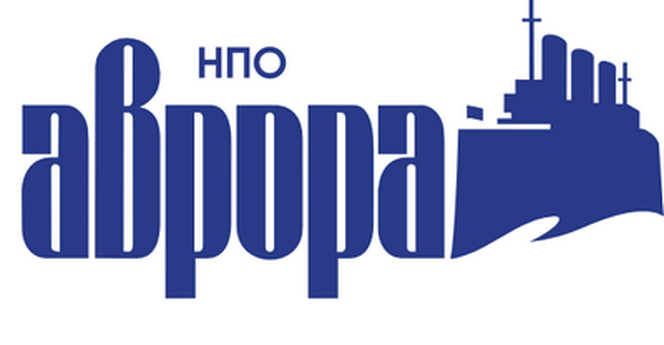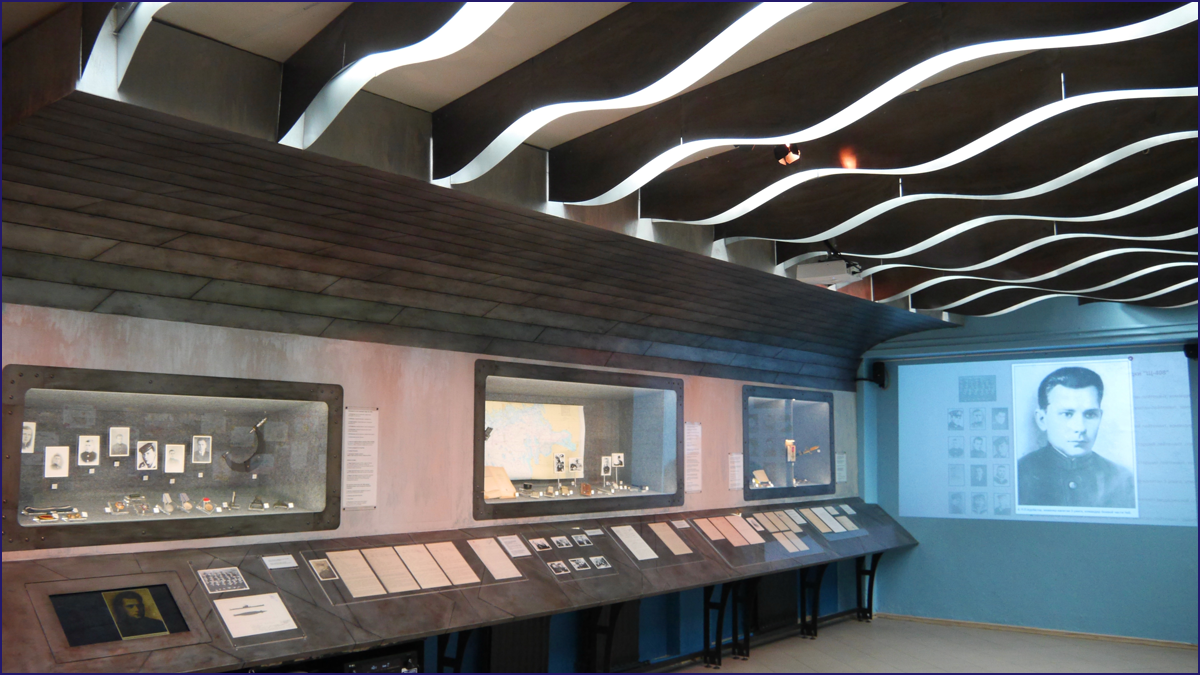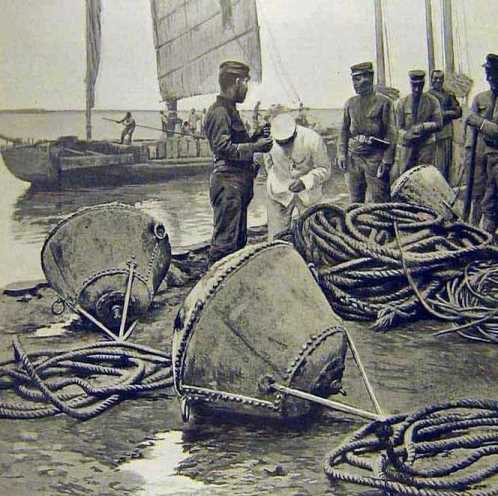53 crew of lost naval submarine declared dead as Indonesia finds wreckage
By Masrur Jamaluddin for CNN
Updated 10:55 AM ET, Sun April 25, 2021
Jakarta, Indonesia (CNN)The wreckage of an Indonesian Navy submarine missing since Wednesday has been found on the seafloor. All its 53 crew are confirmed dead, Indonesia military commander Air Chief Marshal Hadi Tjahjanto said Sunday.
The news came a day after debris believed to be from the KRI Nanggala-402 submarine was found floating about two miles from the submarine's last known location in the Bali Strait, leading military officials to change the vessel's status from missing to sunk.
Indonesia's Rigel warship scanned the area with sonar, which uses sound waves to locate objects, and a magnetometer, Tjahjanto told a news conference. The MV Swift Rescue ship from Singapore then sent a remotely operated vehicle (ROV) to get more explicit underwater visual imagery, he said.
"We found and confirmed an image of Nanggala submarine parts, like horizontal steering, anchor, exterior body, vertical steering, and other submarine parts like safety suits for the crew," he said.
"Based on that authentic proof, I declare here that the Nanggala submarine sank, and all of the crew died."
A rescue ship from Singapore sent a remote operated vehicle to get clearer underwater visual imagery of the sub.
A rescue ship from Singapore sent a remotely-operated vehicle to get more precise underwater visual imagery of the sub.
The submarine was found at a depth of 850 meters (930 yards) and had broken into three parts, Indonesian Navy Chief of Staff Adm. Yudo Margono said.
Among the objects found by the search team was a submarine escape immersion suit, he said. "This suit is only used to escape in emergencies. Normally it is stored inside the box, but since we found it outside, we believe that the crew was going to wear it, but they had no chance," he said.
Regarding the cause, Margono said, "this is not a human error, but a natural/environment factor," but did not give further details.
Briefing journalists Saturday, the admiral said an explosion was not thought to have occurred on the submarine but that heavy pressure on the vessel likely caused it to crack.
Tjahjanto extended his deepest condolences to the families of the crew, known as the Golden Shark unit, and said all those on board would be given honors and an increase in rank.
The Indonesian government will work with the International Submarine Escape and Rescue Liaison Office, and he said, "because to evacuate the Nanggala submarine, we need international cooperation."
Indonesian President Joko Widodo offered condolences Sunday to the crew's families, whom he described as the country's "best patriots."
"This tragedy shocked all of us. Not only the families of the 53 crew members... but also the entire Indonesian people," he said.
Hopes of finding any of the crew alive had already dimmed Saturday when debris including a bottle of grease, part of a torpedo launcher, part of a metal tube, prayer mats, and fuel was found floating at a location where the sea is 850 meters (930 yards) deep.
Authorities said earlier the submarine could not survive at depths beyond 500 meters. The crew was also expected to have run out of oxygen early on Saturday.
The German-made submarine lost contact during a military exercise in the Bali Strait early on Wednesday morning.
https://www.youtube.com/watch?v=4FlWmCBdjXY
USSVI GROTON BASE
SPECIAL BROADCAST
KRI NANGGALA (402) REMEMBRANCE
APRIL 21, 2021
On April 21, 2021, the KRI NANGGALA 402 was lost at sea. As fellow submariners, we all know too well the sacrifice that our fellow submariners on the NANGGALA made. I ask that we all take a moment and reflect not just on the sacrifice the NANGGALA have made but the terrible loss their families are going through now.
O Father, Hear our prayer to thee
For your humble servants
Beneath the sea
In the depths of oceans, as oft, they stray
So far from night, so far from day
We would ask your guiding light to glow
To make their journey safe below
Please oft times grant them patient mind
Then ‘ere the darkness won’t them blind
They seek thy protection from the deep
Please grant them peace when ‘ere they sleep
Of their homes and loved ones far away
We ask you care for them each day
Until they surface once again
To drink the air and feel the rain
We ask your guiding hand to show
A safe progression sure and slow.
Dear Lord, please hear our prayer to thee,
For your humble servants
Beneath the sea.
Amen
Jeff Walsh
USSVI Groton Base
Base Commander (commander@ussvigroton.org)
Bob South Jr. Submitts this message:
Copied from a Brother of the Deep
We mourn the Nanggala 402 as we mourned the ARA San Juan before her and the Kursk before that.
We mourn her regardless of her nationality because the true enemy of the submarine is the ocean.
Many love to walk the white sand beaches and listen to the gentle roll of the waves - basking in the “Salt Life.” But the submariner knows.
The ocean is angry - she is relentless - and she is unforgiving. She wants to be inside your pressure hull - your very presence in her depths is an affront to her. She wants to crush it like an aluminum can and take it all inside to unreclaimable depths. And she NEVER stops- she waits for one weakness - for one error.
So tonight, we raise one to the 53 souls gone with the Nanggala and now on eternal patrol. And we raise a second to the men on countless boats that are out now and will go out tomorrow.
RIP. Sailors, rest your oars. We Have the Watch.
Join 31 Other Nation's Submariners for fun and travel; once this Virus is gone.
1.Consider becoming a member of the ISA-USA; you will benefit in many ways.
2.Be part of a 50-year tradition of international friendships of submarine sailors. Check out www.submarinersorg for the history of the International Association
3.Travel to foreign countries to participate in conventions that usually include thirty-one states in attendance.
4.Establish friendships with submariners from other nations.
5.Contribute your Submarine history and experience to our World Wide e-mail blast.
We Cheerfully accept members that have not served but are interested in worldwide submarine activities
ISA/USA Lifetime membership only $50.00.
ISA/USA Membership Application. All new ISA/USA members receive a Membership card, ISA/USA Patch, and a new larger Vest Pin. On our weblink below and print an application:
Send completed form and membership fee to:
John Bud Cunnally E.T.C. (S.S.) Ret. U.S.N. – President
International Submariners Association of the U.S.A. (ISA/USA)
4704 Coppola Drive
Mount Dora, Fl 32757-8069
Norway, US Bolster Russian Sub Watching With New Bases
The US government will pay for all facilities it builds on Norwegian soil and will not permanently base any troops there, officials in Oslo were quick to point out.
Three Norwegian Air Force F-16s and a US Air Force B-52H fly over the Barents Sea above the Arctic Circle.
WASHINGTON: American and NATO ships, submarines, and aircraft will soon come calling at a handful of new ports and airfields in the Norwegian Arctic, thanks to a significant new pact signed Friday.
The Supplementary Defense Cooperation Agreement will allow the US to build infrastructure at three air bases and a navy facility along the Norwegian coast to bolster American and NATO allied operations in the Arctic and North Atlantic.
The agreement must still be ratified by the Norwegian Parliament, a move expected by the summer.
Once it’s approved, the US will start building new facilities at the Rygge, Sola, and Evenes airfields, along with the Ramsund navy base, while rotating troops and contractors to those bases to maintain facilities and service US aircraft and ships.
The Ramsund facilities would mark the second base where American submarines and ships can regularly resupply along Norway’s North Atlantic coast, following the expected opening of the Tromso port even further north to American submarines in the coming weeks after undergoing a significant expansion effort last year.
As for the airbases, Rygge sits on the outskirts of Oslo, while Sola is on the Atlantic coast in southern Norway and Evenes above the Arctic Circle in the north. The new capabilities for American and NATO allies to land so far above the Arctic Circle would place them closer to increased Russian activity in the North Atlantic and the Arctic.
The new work is likely to include facilities for P-8 surveillance planes and B-1 bombers, which would use the bases as a launching pad to monitor Russian submarines sailing from Northern Fleet’s main base on the Kola peninsula, hard up against the Norwegian border.
The US government will pay for all facilities it builds on Norwegian soil and won’t permanently base any troops there, officials in Oslo were quick to point out. It’s a point the Norwegian government has long stressed when talking about US Marine rotations to the country for training.
AIR WARFARE, SPONSORED
Engagement vs. Estrangement
Arms Sales Strengthen Key Alliances And Keep Partners Close To Washington
From NICOLA “NIKI” JOHNSON, VICE PRESIDENT FOR GOVERNMENT AFFAIRS, STRATEGIC COMMUNICATIONS AND MARKETING GENERAL ATOMICS AERONAUTICAL SYSTEMS, INC.
“Our cooperation with our allies is under continuous development,” said Norwegian Minister of Foreign Affairs Ine Eriksen Søreide. “The agreement reaffirms Norway’s close relationship with the US and confirms Norway’s key position on the northern flank of NATO…our policies regarding the stationing of foreign forces on Norwegian territory, the stockpiling or deployment of nuclear weapons and port visits remain unchanged,” she added.
Last month, two US B-1B bombers visited Orland Main Air Station about 350 miles north of Oslo for a short deployment.
While the exact scope or timing of any of the proposed construction remains unclear until final approval, Defense Minister Frank Bakke-Jensen said in an interview with the Barents Observer that fuel supply facilities will be built at Rasund.
The Orland and Evenes airfields will not only see more American aircraft, but will be the main operating bases for Norway’s growing fleet of F-35s. Norway has been quick to integrate the F-35s they have already taken possession of into NATO exercises, and the country will eventually operate 52 F-35As, which will be joined beginning in 2022 by five new P-8 surveillance aircraft.
CIA graphic
Recommended
Why Putin Threatens Ukraine
Ukraine has been the number one target of Putin’s new-age imperial ambitions. He has consistently refused to recognize the legitimacy of Ukraine’s independence, stating Ukraine is not a “real country” and that it will always be part of the “Russian world.”
By REUBEN JOHNSON
The additions to the bases and the Norwegian buildup reflect the deep concern NATO has over the Russian buildup in the High North. Testifying before the Senate Armed Services Committee last week, European Command chief Gen. Tod Wolters said advances in Russia’s submarine fleet, “and expanding maritime strategic goals have reinvigorated Russia’s access to the broader Atlantic Ocean,” require increased diligence by the US and its allies in the region.
Submarine Industrial Base Under Strain as Virginia-Class Parts Wearing Out Early; Implications For Columbia-Class
By: Megan Eckstein
April 20, 2021 2:24 PM
Some parts on Virginia-class attack boats are wearing out faster than the Navy anticipated 20 years ago, and buying replacement parts is further straining a nuclear submarine industrial base that’s already juggling an expansion of construction of new hulls and maintaining the current fleet.
The Navy has found that engineering analysis from 20 years ago isn’t holding up compared to actual attack boat performance in the fleet. During the Virginia-class attack sub (SSN-774) design phase, the Navy had expected “that parts were going to be on the ship and fully functional for longer than it’s turned out to be,” Rear Adm. Ed Anderson, who commands the undersea warfare directorate at Naval Sea Systems Command (NAVSEA 07), said last fall at the annual Naval Submarine League conference. As a result, the Navy is writing contracts “for parts that we never thought we were going to replace on the ships that we’re replacing early” – which has implications for the already strained industrial base.
“We’re finding that some of our engineering assumptions and analysis are not bearing out, so that’s causing some changes to class maintenance plans, it’s causing some changes to the resource on the ships and provisioning. And we’re using the data that we’re getting from the fleet to make that [provisioning] as effective for the fleet as possible. … And everything we’re learning here is going to Columbia class and [Rear Adm. Scott] Pappano there, PEO Columbia, to make sure that ship is as resilient as possible,” Anderson said at the event, noting that there are many commonalities between the Virginia-class and Columbia-class ballistic missile submarine (SSBN-826) design and materials in certain areas of the boats.
Anderson declined to say at the event or in recent comments to USNI News which components were wearing out faster than expected. Still, he referred to commercial-off-the-shelf (COTS) parts on several occasions. The Navy, during the Virginia class design phase in, touted the command, control, communications, and intelligence (C3I) systems’ electronics as being a focus of its efforts to use COTS components to save money upfront and provide flexibility, later on, to upgrade the system as needed, the service said in 1999.
The Virginia-class fast-attack submarine USS Missouri (SSN 780) departs Pearl Harbor on May 10, 2020, after completing a scheduled extended dry-docking selected restricted availability (EDSRA). Missouri’s routine maintenance and modernization work was completed five days ahead of schedule after successful sea trials and certification.
A source familiar with the submarine industrial base told USNI News that this type of learning would happen with any new ship class, as engineering assumptions come face-to-face with actual data from the fleet. However, because the industrial base in some areas is already strained to keep up with demand for new construction for SSNs and now SSBNs, the source said conversations have happened about whether certain components need to be redirected to an in-service boat that needs the parts to complete repairs and get back out to the fleet, versus if the components need to go to a new-construction submarine that cannot afford any further schedule slips.
“The Virginia-class submarines brought evolutionary changes to submarine construction and maximized the use of commercial off the shelf (COTS) technology, where possible. This resulted in tremendous procurement value; however, it is still one of the most complex combat systems fielded, and submarines operate in one of the most strenuous and unforgiving environments,” Anderson told USNI News in written comments this month.
“In addition to the engineering reliability predictions – which are being re-addressed across new construction and sustainment of operational submarines – there are robust programs to track and assess failures enabling evaluations of both short-term and long-term corrective actions necessary for total lifecycle management.”
He added that the Navy is looking hard at this issue and has two main levers to work with: parts of the Virginia and Columbia design can be reworked to get rid of the components that are failing early, or the supply system can be bolstered so that more spares are available when the components do fail.
“On a case-by-case basis, there have been some manufacturing quality issues, but most of the issues seem to be design related. Redesign and adjusting the class maintenance plan (CMP) are both options, and the most suitable solution depends on each individual challenge and maintaining a balanced approach,” he wrote.
“Monitoring and utilizing metrics data and trends to inform the Virginia-class block procurement strategy allows for earlier identification and replacement of prematurely failing components via update of the CMP to reflect the true maintenance periodicities for affected components and/or improve engineering design/redesign efforts to fix problems that have been discovered in the earlier [Virginia-class blocks]. This initiative will be extended to [Columbia], where continued improvements will be made. All of these redesign efforts and corrective actions can then be leveraged for in-service backfits, as appropriate.”
Before the Navy can make these decisions to rework part of the design or to alter class maintenance plans, the service needs good data on how frequently components are actually failing. Anderson said during the November Sub League event that the Navy made an early mistake in failing to collect data as soon as these component problems began.
Early in the Virginia program, the Navy saw some cannibalism in early maintenance availabilities, where a part was taken off one SSN so that another could be made whole and return to operations. Anderson said the Navy didn’t capture that data early on, meaning the service didn’t realize it had a problem and didn’t react quickly to fix it.
Today, though, “we are capturing every movement of a part so that the supply system can see the demand, and that is really important to solving the problem long-term.” That data is important – the Navy plans the bulk of its maintenance availabilities upon expectations of what work will need to be done, rather than the actual material condition of a specific hull, so having accurate data on component failure rates would drive better maintenance planning and earlier ordering of parts.
The rear admiral told USNI News that the Virginia and Columbia program offices and PEOs are working together and with the Navy public shipyards to leverage data analytics and lessons learned from past maintenance work to improve material forecasting for future planned and condition-based maintenance efforts, and to ensure that “new construction liabilities” are understood and incorporated into maintenance work packages.
“In addition, the shipyards have begun to mitigate sustainment issues through earlier ordering, which requires re-phasing of material orders – and funding – to support very long lead material requirements for availabilities. Material ordering shifted earlier is a proven way to get ahead of lead times, reduce material work stoppages and maintenance delays awaiting components,” Anderson said.“For our in-service submarines, we are developing solutions for components not meeting their mean time between failure threshold. We are also looking at this from an end-to-end analysis, from design to sustainment, including lifecycle analysis and sustainment engineering.”
Though this type of learning may occur on all new programs, it comes at a precarious time for the submarine community: a strained industrial base, with sole-source vendors for some components, is trying to keep the Columbia program on schedule after the Navy has made clear it cannot afford any delay at all, and also trying to ramp up Virginia-class production for a future fleet that will rely more heavily on undersea warfare. Though the Navy has been tight-lipped about where vulnerabilities in the industrial base lie, and which components are now wearing out faster than planned and will require more from industry to build a greater pool of spare parts, these component failures could add risk to two programs that can’t afford it.
Anderson said the Navy is keeping close tabs on industry, and the source familiar with the industrial base told USNI News that Navy efforts over the past couple years have improved the resiliency of the industrial base.
“The Navy and our shipbuilder team perform annual assessments of the vendor base to understand in detail the specific improvements and initiatives needed to ramp up to meet an increased demand. These studies have extensive shipbuilder and industry engagement, assessing areas such as machines, buildings and the workforce,” Anderson said.
“Based on the work already done on vendor assessments, the Navy is fully aware of the strengths and areas for improvement. The Navy is focused on partnering with both the shipbuilders and the vendor base to ensure that the required capacity is achievable as the demand continues to grow.”
As for the impact on Columbia, which is the Navy’s top acquisition priority, Anderson wrote that “the Columbia Program has and continues to proactively take into account lessons learned from the Virginia Class. This is an essential part of the Integrated Enterprise Plan (IEP), which involves working with key vendors through construction. In some instances, material issues identified on Virginia Class are being addressed via Columbia Program technology refresh efforts. Technology refresh involves proactive replacement of older equipment with newer, more supportable hardware and software. It is a proactive approach to ensure the reliability, maintainability, and availability of systems and equipment as required to meet Columbia requirements.”
Bottom line, he said during his November speech, is that the Columbia program has learned that “we’ve got to make sure that those electronic systems are well-stocked” so that component failures don’t cause maintenance and operational disruptions.
Home naval-todayBAE Systems launches Royal Navy’s 5th Astute-class sub
BAE Systems launches Royal Navy’s 5th Astute-class sub
VESSELS
April 21, 2021, by Naida Hakirevic
Anson, the fifth of seven Astute-class attack submarines being built for the Royal Navy, has been launched at BAE Systems’ site in Barrow-in-Furness, Cumbria.
The 7,400-tonne nuclear-powered submarine, officially named at a ceremony in December, emerged from the Devonshire Dock Hall and entered the water for the first time on April 20 2021.
BAE Systems
Anson will now begin the next phase of its test and commissioning programme, before leaving Barrow for sea trials with the Royal Navy next year.
“The launch marks an important milestone in the Astute programme and seeing Anson enter the water at such an advanced state is a tangible demonstration of everyone’s hard work over the years. Designing and building nuclear-powered submarines is a national endeavour and days like this bring a huge sense of pride,” Steve Timms, Managing Director BAE Systems Submarines, commented.
“We now look forward to a successful test and commissioning phase and working alongside Anson’s crew to prepare the submarine for operations with the Royal Navy.”
The Astute class boats are the largest and most advanced attack submarines ever built for the Royal Navy. Measuring 97 metres in length, the boats can circumnavigate the globe submerged, producing their own oxygen and drinking water.
The first four submarines in the class, HMS Astute, HMS Ambush, HMS Artful and HMS Audacious, have been handed over to the Royal Navy, with a further two boats currently under construction at our Barrow site.
Working alongside the Submarine Delivery Agency and Rolls-Royce, the company is also a member of the Dreadnought Alliance, helping to deliver the UK’s next class of nuclear deterrent submarines. Two of the four submarines are under construction, with the first due to enter service in the early 2030s.
Russia develops submersible patrol ship
April 16, 2021, by Naida Hakirevic
Russian submarine designer Rubin Design Bureau revealed it has developed a submersible patrol ship combining the features of a submarine and a surface patrol vessel.
Named Sentry (Border and Offshore Submersible Sentry, BOSS), the concept is intended for foreign clients, according to Rubin.
Offshore patrol vessels are relatively inexpensive, which makes them affordable for countries with constrained budgets. Their operation is profitable because they can be used to prevent illegal trade, poaching and other law infringements. Ships of this type are multi-functional and can be used as patrol ships, and as rescue or research vessels as well. Equipment for the new ship comes mostly from surface ships and aircraft and is commercially available, the company said.
As explained, the ability to dive allows the ship to carry out discreet surveillance operations and evade harsh weather conditions without aborting the mission.
A submersible ship can be used as a submarine, for intelligence, surveillance & reconnaissance (ISR), as well as other missions. Seabed research capability of the submersible patrol ship would be wider than those of a surface ship.
It can also serve as an inexpensive training vessel to give crews seagoing experience and prepare the infrastructure before purchasing traditional submarines at a later stage.
In its architecture and outline, the ship resembles the Soviet Union’s https://www.kchf.ru/eng/ship/submarines/s360.htm (Project 613). Basic parameters are also much the same, with the surface displacement of around 1,000 tons, overall length of 60 to 70 metres depending on the configuration, and the crew of up to 42 people including the boarding team.
There will be large pressure-proof containers that can be used to store rigid hull inflatable boats (RHIBs) or unmanned aerial vehicles (UAVs). The latter’s launch sequence will be automated, not requiring the presence of people on the ship’s open deck.
The ship can be fitted with torpedoes, small guided missiles and autocannon.
Thanks to our Friend in the UK Kenny Strode
The Submerged History of the Submarine
Submarines played a major role in Word War I. But the first submersible was actually used, though unsuccessfully, in the Revolutionary War.
via Wikimedia Commons
By: Matthew Wills
On July 1, 2019, a fire on a Russian nuclear-powered submarine in the Barents Sea killed fourteen of the crew. According to Russian sources, they died preventing a “catastrophe of global proportions.” The nature of that catastrophe was not specified, but it’s hard not to be hyperbolic when reactor meltdowns or explosions are worst-case scenarios.
The Losharik’s mission was top secret. Submarines do tend to evade attention; that’s their tactical advantage. Hundreds of them are deployed around the world. At least forty nations have one in their fleet.
It was a thing of Connecticut Yankee ingenuity: essentially an oak barrel with clockwork mechanics that used water ballast to control its depth.
Where did these monsters of the deep come from? Frank Uhlig, Jr., special projects editor at the U.S. Naval Institute, has written a somewhat surprising history of submarine origins. He reveals that the U.S. Navy, which led modern submarine development, acquired its first sub in 1900. The first submersible used in combat, however, pre-dated this by 124 years.
During the American Revolutionary War, inventor David Bushnell and mechanical wizard Isaac Doolittle put together that first submersible, the Turtle. It was a thing of Connecticut Yankee ingenuity: essentially an oak barrel with clockwork mechanics that used water ballast to control its depth. With volunteer Ezra Lee hand-cranking the propeller, the Turtle set out to blow up the British Navy’s flagship in New York Harbor in 1776.
The Turtle Submarine
The Turtle Submarine via Wikimedia Commons
After fighting the tide for two hours to get to the HMS Eagle, Lee couldn’t attach his mine to the enemy vessel. A later effort further up the Hudson River also failed. (Artist Duke Riley created a submersible that paid homage to the Turtle‘s adventure in 2007; authorities were not amused when his submersible approached the Queen Mary II not so far from the site of the original would-be attack.)
The failure seemed to have lasting repercussions. In the early 1800s, when steamboat pioneer Robert Fulton tried selling a submarine to the British to use against the French, they told him to go away. When he tried selling it to the French, Napoleon wouldn’t talk to him. After the curious case of the Turtle, the development of submarine warfare was somewhat dormant for eight decades.
Then, in 1864, the Confederate States of America ship Hunley, with nine men aboard, successfully sank the USS Housatonic during the blockade of Charleston, South Carolina. Like the Turtle, the Hunley was powered by hand-cranking. Its weapon was a spar torpedo, an explosive device attached to a long pole. Five members of the Housatonic’s crew died in the attack. But also, every man on the Hunley perished. Submarines were proving to be deadly, in a variety of ways.
Uhlig writes that in the late nineteenth century and early twentieth century, John Holland’s use of a gasoline engine and diving planes put the U.S. at the forefront of modern submarine technology. The first United States Navy sub was named Holland in his honor. On the eve of World War I, the U.S. had thirty submarines. Britain had seventy-three; France fifty-five; Russia twenty-two. German had twenty-eight, a number which would quickly grow. World War I saw more ships sunk by submarines than by surface ships. Unrestricted submarine warfare waged by the Imperial German Navy, including the sinking of many merchant ships, was one of the factors drawing the U.S. into the war.
All technologies of warfare inspire counter-measures. Depth-charges, sonar, and the convoy system, in which groups of merchant ships are protected by a screen of warships, all emerged from WWI. Countermeasures are, of course, met with further counter-countermeasures. A century after WWI, submarines still prowl the deeps, while ways of fighting them follow hard on their underwater heels.
Regards
Ian Vickers
National Secretary
Submariners Association
secretary@submarinersassociation.co.uk
A New Submarine Book
‘Fly Just Right of the Sun’ by Gordon Gledson
Synopsis:
“Victorian society considered two things alien and unnatural - submarines and mental disorder. Put the two together and you have a compelling combination that makes you turn page after page.
‘Fly Just Right of the Sun’ is a story about a Captain’s lonely descent into mental illness, and the cruel effects it has on his career, and life.
Commanding an experimental submarine in 1899 and diving deeper than any human being has ever gone, is frightening, and for some, unbearable.
Having to hide his mental problems, the Captain is forced to live a life of pretence, and charade, whilst being closely confined with tough men.
Any man who crumbles under these circumstances should be excused, but military failure is not acceptable in Victorian society, they demand more from their Officers, more than some men can give.”
The Author:
Gordon Gledson says: My father was a Royal Navy diver in the Second World War, and I served in the Royal Navy on the submarine rescue ship, HMS RECLAIM. I have written a novel about an experimental submarine in 1899 and I wonder if it would be of interest to your members. It is called ‘Fly Just Right of the Sun’.
It is free if anyone is a member of Kindle Unlimited otherwise it is only 99pence on Kindle or Amazon.
Gordon would be happy to discuss the book with anyone who would like to email him on gordongledson@btinternet.com. He would appreciate the feedback.
Russian and Chinese Nuclear Threats Pose Problem for U.S. Deterrence, Experts Say
By: John Grady
April 8, 2021 11:44 AM
Russian and Chinese threats to use nuclear weapons in Europe or across the Taiwan Strait pose “stark real-world problems” in defining deterrence as the United States modernizes its strategic forces, security experts agreed Wednesday.
While the three panelists and keynoter speaker former Sen. Jon Kyl (R-Ariz.) said modernizing all legs of the triad and the weapons systems was essential, Keith Payne, the chief executive officer of the National Institute for Public Policy, said “deterrence requirements can change, can change very quickly.” He added, “the outside world has a vote” on what’s needed for deterrence and “the outside world has changed dramatically” since 2010, when the Obama administration reevaluated the Strategic Arms Reduction Treaty [START] with Russia.
During a virtual Heritage Foundation and Ronald Reagan Presidential Foundation and Institute event, Payne and the others noted the administration at the time committed itself to modernizing its land-based ballistic missile systems, strategic bomber force and the nation’s ballistic missile submarine fleet and the weapons themselves.
Rebeccah Heinrichs of the Hudson Institute said “baked in” to American military planning is the belief that “our nuclear deterrence will hold.” The “nuclear umbrella” also is key to holding the nation’s alliances together, panelists said.
In the next decade, “the Russians have lowered the threshold in which they might employ a nuclear weapon” in a dispute with another nation, Heinrichs said.
Adding in China, which is expected to at least double its nuclear weapons stockpile in a decade, as well as North Korea and possibly Iran, Payne said,”the threat context is becoming more and more challenging.” The threat includes mobile intermediate-range cruise missiles to sophisticated air defense systems and dual-use, supposedly simple weapons like mines.
Heinrichs put the Russian advantage over the United States in tactical nuclear weapons at 10 to 1. Kyl said the Russians have achieved more than 85 percent of the nuclear platform and weapons system modernization, and China could be aiming to triple its nuclear stockpile to 600 weapons in the next few years.
Moscow and Beijing are ignoring the Cold War “balance of terror” argument – that any nuclear exchange would be suicidal – when they ratchet up the possibility of using tactical nuclear weapons. Russia calls the policy “escalate to de-escalate.”
“The way the conflict is de-escalated is because the West stood down,” Kyl added.
Payne said the question now and into the foreseeable future is “what nuclear risks are they willing to accept” in those regional crises.
Matthew Kroenig, of the Scowcroft Center at the Atlantic Council, said “China arguably has a [nuclear] threat advantage over the U.S.” in the Indo-Pacific.
Since Beijing is not constrained by the START Treaty or by the Intermediate-Range Nuclear Forces [INF] treaty, China “may be in a sprint to nuclear parity” with the U.S. in the region. He added he could envision a scenario in which a Chinese attempt to take over Taiwan goes badly and Beijing then threatens to use tactical nuclear weapons against the island.
“Russia has done ‘escalate to de-escalate,’ China could do that,” despite its avowed “no first-used policy” regarding nuclear weapons.
Kroenig said the Trump administration adjusted to some of the new challenges by pulling out of the INF, beginning work on missiles with intermediate range and also proposing the development of nuclear-capable sea-launched cruise missiles.
In his opening remarks, Kyl said, “we brought the problem on ourselves” of having to pay for modernized platforms and weapons systems at the same time. By not investing continuously after 2010 in the platforms, Washington now finds “both bills are coming due at the same time.”
With questions being raised about the value of modernizing land-based ballistic missiles, “we do not have the consensus we had back in 2010,” he said.
“China and Russia are both relying on a triad” in their strategic planning. Kyl said the spending commitment of two to three percent above the rate of inflation would need to run for 10 to 15 years. Reports this week predict that the U.S. defense budget will be flat at $704 to 708 billion.
Service officials have forecast flat or declining budgets in the coming years and emphasized a need to prioritize modernization over legacy platforms. Politico and Bloomberg reported that the topline for the Fiscal Year 2022 budget – which has yet to be released – will be between $704 and $708 billion.
DREADNOUGHT-CLASS SUBMARINES TO GET 'FLY-BY-WIRE' TECHNOLOGY
April 1 2021
‘Fly-by-wire’ technology in aircraft will be introduced to the Navy’s next-generation submarines.
The same thinking behind digital cockpits in 21st Century aircraft and helicopters will control key aspects of the Dreadnought class of submarines beneath the waves including heading, pitch, depth and buoyancy.
Four of the boats are being built by BAE Systems to replace the existing quartet of nuclear deterrent submarines based at Faslane.
The Vanguard class are children of the 1980s, their movements controlled manually by ‘planesmen’ operating aircraft-like control sticks. It’s a demanding job – particularly keeping a 16,000-tonne submarine level.
With decades of experience in flight controls, BAE believes it can adapt fly-by-wire technology – where computers replace the manual input from operators – to Dreadnought and her sisters.
The Active Vehicle Control Management system will oversee all major aspects of the Dreadnoughts’ manoeuvring with added safety benefits.
More than 130 engineers, technicians and experts are already working on the system at BAE’s Rochester site – the first major work for the Royal Navy conducted in the area since Chatham dockyard closed nearly 40 years ago.
“With over 50 years of avionics experience, we already have a great understanding of how to develop complex, control systems for hi-tech platforms,” said Jon Tucker, Director for Maritime Controls at BAE Systems Controls and Avionics.
“However, taking our technology underwater brings exciting new challenges and we are proud to support the Dreadnought programme and play an important part in our national security effort.”
USS Johnston: Sub reaches world’s deepest shipwreck
VESSELS
April 2, 2021, by Naida Hakirevic
An expedition privately funded and executed by two former US Navy Officers has successfully re-located, surveyed, and filmed the USS Johnston (DD-557), the world’s deepest known shipwreck that principally lies at a depth of 21,180ft (6,456m) in the Pacific Ocean.
Intrestingly, the wreck of the destroyer Johnston was located in water 62% deeper than where the RMS Titanic lay in the North Atlantic.
The funder of the expedition, Victor Vescovo, is a former US Navy Commander (Ret.) who personally piloted his submersible DSV Limiting Factor down to the wreck during two separate, eight-hour dives. These constituted the deepest wreck dives, manned or unmanned, in history, according to Caladan Oceanic.
The USS Johnston (DD-557) was a US Navy Fletcher-class destroyer that sank in battle on October 25 1944. The Johnston measured 376 ft (115m) long with a beam of 39ft.
The ship was sunk during an intense battle against vastly superior Japanese forces off the coast of Samar Island during the Battle of Leyte Gulf, widely cited as the largest naval battle in history.
The wreck, the deepest shipwreck ever located, was originally discovered in 2019 by the late Paul Allen’s vessel R/V Petrel under the leadership of renowned ocean wreck explorer Robert Kraft. On that expedition, film of pieces of the vessel were taken by a remotely-operated vehicle (ROV), but the majority of the wreck including its upright, intact forward two-thirds including bow, bridge, and mid-section lay deeper than the ROV’s rated depth limit of approximately 20,000ft (6,000m).
It has now been discovered that its hull number “557” is clearly visible on both sides of its bow and two full 5” gun turrets, twin torpedo racks, and multiple gun mounts are still in place and visible on the superstructure. No human remains or clothing were seen at any point during the dives and nothing was taken from the wreck.
Extensive research by naval historian and Annapolis alumnus LCDR Parks Stephenson, USN (Ret.) allowed the position of the wreck to be plotted as part of the development of a dive plan.
“We used data from both the US and the Japanese accounts and as is so often the case the research brings the history back to life. Reading the accounts of the Johnston’s last day are humbling and need to be preserved as upholding the highest traditions of the Navy. This was mortal combat against incredible odds.”
Vescovo has held ongoing discussions with Navy Heritage and History Command (NHHC) about investigation of the wreck and the protocols for not only preserving it but respecting it as the final resting place for many of its crew.
All of the sonar data, imagery and field notes collected by the expedition is not to be made public but will, however, be provided to the US Navy for dissemination as it deems appropriate at its sole discretion.
“We have a strict ‘look, don’t touch’ policy but we collect a lot of material that is very useful to historians and naval archivists. I believe it is important work, which is why I fund it privately and we deliver the material to the Navy pro-bono,” said Vescovo.
“The Naval History and Heritage Command greatly appreciates the efforts of Commander Vescovo and his expedition team in positively identifying the wreck of the destroyer USS Johnston (DD-557,) lost on October 25 1944 in one of the most heroic actions in the entire history of the U.S. Navy,” Rear Admiral Samuel Cox, Director of Naval History and Curator for the Navy said
“Commander Ernest Evans and his entire crew went above and beyond the call of duty engaging an overwhelming and vastly superior Japanese force to buy time for the escort carriers he was charged with protecting, to escape. The Johnston was awarded a Presidential Unit Citation — the highest award that can be given to a ship. Evans was awarded a posthumous Medal of Honor, the first Native American in the U.S. Navy and the only destroyer skipper in World War II to be so honored.”
Three other ships lost in the same battle have yet to be found.
Progeny Systems to build and upgrade submarine combat system to control weapons on Navy fast-attack boats
The PCS controls torpedoes, mines, cruise missiles, unmanned underwater vehicles (UUVs), unmanned aerial vehicles (UAVs), and countermeasures.
April 20, 2021
Submarine Combat System 20 April 2021
WASHINGTON – Undersea warfare experts at Progeny Systems Corp. in Manassas, Va. will continue building and upgrading an integrated system to help submarine crew members control submarine combat weapons such as torpedoes, missiles, mines, and unmanned underwater vehicles (UUVs).
Officials of the Naval Sea Systems Command in Washington announced an $8.7 million order to Progeny late last month for options to the Payload Control System (PCS) for technical insertion advanced processing builds. PCS is the software portion of the AN/BYG-1 submarine combat control system for all Navy submarines.
The AN/BYG-1 is installed on the U.S. Navy Los Angeles-, Seawolf-, and Virginia-class fast-attack submarines, as well as on Ohio-class cruise missile submarines and on Australian Collins-class attack submarines. The AN/BYG-1 submarine combat system has three separately developed and integrated software applications, of which the PCS is one part.
The others are the Tactical Control System (TCS), which provides contact management and decision management functions; and the Information Assurance (IA) application, which includes the networking infrastructure to maintain separate security enclaves and downgrade system disk drives.
Related: General Dynamics to upgrade submarine combat system software aboard attack and missile boats
The PCS is an integrated, mission-critical subsystem that enables the operator control all current and future submarine payloads, including torpedoes, mines, tomahawk cruise missiles, modular undersea heavyweight vehicles (MUHVs), UUVs, unmanned aerial vehicles (UAVs), and countermeasures.
The Progeny-developed PCS software operates on processing, display, and launcher tactical hardware that the Navy procures from other companies. Progeny experts will design, upgrade, test, and deliver the PCS software for all Navy new construction and in-service submarines and appropriate joint program office submarine platforms, Navy officials say.
On this contract Progeny will do the work in Manassas, Va., and should be finished by April 2022. For more information contact Progeny Systems online at www.progeny.net, or Naval Sea Systems Command at www.navsea.navy.mil.





